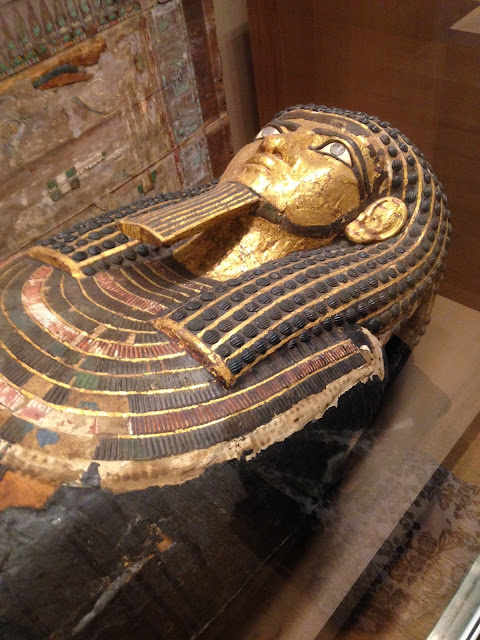Day 395 - Portraits of the rich and famous
January 6, 2025
When I glanced earlier into gallery 618, my first thought was, "It's all about van Dyck." There are a number of van Dycks in the gallery, but the larger theme is that court portraiture in the 17th century tended to be flamboyant: financiers, administrators, and others associated with royal courts wanted portraits that conveyed their wealth and power.
The oh-so-politically-correct signage informs us that portraiture "bestowed a veneer of respectability on igures whose wealth often came from the exploitation of other individuals - including enslaved people - who rarely appear in portraits." Well, yes - but doesn't wealth almost inevitably involve exploitation, and isn't high culture dependent on wealth for its existence? Sometimes, the wall signs lay it on with a trowel. In describing Jean-Baptiste Colbert, Louis XIV's minister of finance and the subject of one of the portraits on display, the sign notes that Colbert promoted policies that sanctioned torture and repression in order to strengthen slavery in French colonies, made Roman Catholicism compulsory, and ordered Jews to leave the colonies. Terrible acts, certainly. But according to Wikipedia, he also worked to promote the domestic economy and was instrumental in founding the royal tapestry works at Gobelins and the Academy of Sciences. A little more balance in looking at historical figures would be welcome.
The introductory signage also notes that more intimate portraits coexisted with these showier ones. A lage Rubens portrait of himself with his wife and young son manages to be both impressive and intimate.
Several other works in the gallery attract my attention. One is van Dyck's large (perhaps 84 inches high and 52 inches wide) full-length portrait of James Stuart, Duke of Richmond and Lennox The young man (he was in his early 20s when the portrait was painted, around 1632-1635) stands in a casual pose, hand on hip; he appears the embodiment of entitlement and privilege. Van Dyck has artfully depicted the luxurious details of his attire, from the shining sunburst ornament on his left sleeve to the fluffy pompoms on his (heeled! Mary Jane-style!) shoes. But what I really respond to is the way the Duke's sinewy greyhound looks up at him adoringly.
Another work I like and admire is Giuliano Finelli's marble bust of Cardinal Scipione Borghese, a powerful patron of the arts. In this work, which is perhaps 36 inches high, and dates from about 1631, Finelli has captured the cardinal's jowly face, with its prominent cheekbones and deep-set eyes. A tuft of hair peeps out from under his cardinal's cap, and his goatee is carved so intricately that each individual hair seems to stand out. I'm not sure whether we're supposed to be amused that some of the buttons on his jacket have some undone, but their fine modeling is certainly an indicator of the sculptor's skill. The wall sign notes that the sculpture also captured the cardinal's personality, saying "it is unsurprising that Borghese's contemporaries judged him a timid man." I don't, however, see timidity - I see a man who's troubled and perhaps a little melancholy. In fact, the internet tells me that Borghese got in some trouble because of his homosexuality. In any event, I am the beneficiary of his wealth and taste as a collector, since my visit to the Villa Borghese was a highlight of my recent trip to Rome.
Finally, I'm drawn again to Nicolas de Largilliere's "Portrait of a Woman and an Enslaved Servant," which I discussed in the day 236 entry and now resides in this gallery. I won't bother to repeat what I had to say then, except to observe, again, that the fact that we first note the woman's opulent gown, then the colorful parrot to her right, then the plant at her feet, and only at last (if at all) the enslaved child behind her says more about slavery than the Met's signage. It shows, better than words can express, how enslavement can be tantamount to erasure.





Comments
Post a Comment